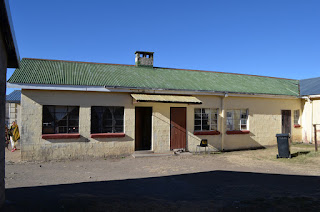 |
| Mthabiseng (Right) & Mamokhalemele |
The maternity ward has always been in high demand here at
St. James. With out a doubt, it is the most used service that St. James
provides to the Mantsonyane community. The current maternity ward opened in
1982. It has space for 10 mothers including a labor room, nursery, antenatal
care, and care for c-section patients. The maternity ward is run by two of St.
James' staff nurses, Mthabiseng and ‘Mamokhalemele.
Expecting mothers show up to St. James sometimes months
before their delivery date. They are housed at the expecting mothers lodge
while they wait for the arrival of their child. The lodge is always busy. On
average, 40-45 babies are delivered every month in the maternity ward. That
means at least 1 baby is born everyday at St. James! That’s not counting the
babies that are born at the 6 other health posts run by St. James. I can only
imagine how many babies the St. James staff has delivered in the past 50 years!
It’s got to be a staggering number.
 |
| Expecting Mothers Lodge |
 |
| St. James' only incubator |
St. James got its first incubator in 1986. This may seem
pretty late, but up until that point St. James was not connected to a reliable
power supply. Today, the maternity ward only has one incubator. The two babies
in the photo were born premature back in late May. They’ve spent the first
month of their lives in the incubator, but I’m happy to say that they are doing
well and will be able to go home soon! Luckily, no other child has needed the
incubator while these two have been in there. With only one incubator, the
maternity staff often has to make very difficult decisions about which babies
need the incubator the most.
 About 15% of births are C-section deliveries. There were 2
C-section deliveries this week. The woman in the photo had her baby earlier
this week. She’s doing well! The child doesn’t have a name yet. Traditionally,
children aren’t named until they return to their village. The second C-section
happened yesterday. Dr. Mack, one of our new doctors from The Congo, performed
the surgery. He invited me into the operating theater to photograph the
procedure, but I respectively declined.
About 15% of births are C-section deliveries. There were 2
C-section deliveries this week. The woman in the photo had her baby earlier
this week. She’s doing well! The child doesn’t have a name yet. Traditionally,
children aren’t named until they return to their village. The second C-section
happened yesterday. Dr. Mack, one of our new doctors from The Congo, performed
the surgery. He invited me into the operating theater to photograph the
procedure, but I respectively declined.  |
| Mthabiseng with the new baby! |
 |
| Dr. Mack in the Operating Theater |
Time sure is going quick! I only have 7 weeks left here in
Lesotho, and there is so much to do in that short amount of time. The website
will be finished by the end of the month, and then next month will be very
busy. HOPE Africa will be making a visit, and I’m pleased to say that Holly
Milburn, the YASCer in Cape Town, will be joining them. Then after that, I’ll
head down to Maseru for a week to work a bit with the Diocesan Offices. After
all that, it will nearly be time to head home! My mind isn’t processing that
yet. Sala Hantle!




